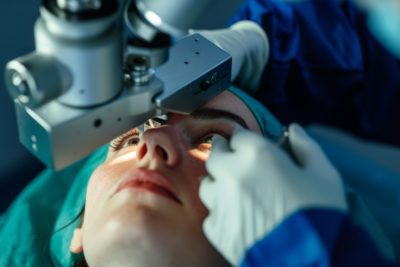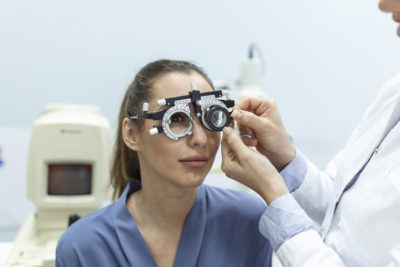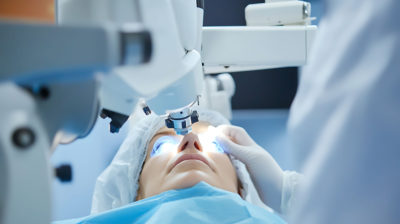Imagine a world where achieving perfect vision is not just a possibility but a personalised reality. Thanks to advancements in laser eye surgery, particularly the revolutionary Wavefront-guided LASIK, this dream has become a clear and personalised vision for many. In this blog, we’ll delve into the fascinating world of Wavefront-guided LASIK, exploring how it works, its benefits, and why it’s changing the way we perceive vision correction.
Understanding the Basics
LASIK, or Laser-Assisted In Situ Keratomileusis, has been a transformative procedure for individuals seeking freedom from glasses and contact lenses. It involves reshaping the cornea—the transparent front part of the eye—to improve how light is focused on the retina. Traditional LASIK has been incredibly successful, but Wavefront-guided LASIK takes it to a whole new level.
Wavefront technology, originally developed for use in astronomy to reduce distortions in telescope images, has found a remarkable application in the field of ophthalmology. In simple terms, it creates a detailed map of your eye, capturing even the tiniest imperfections that can affect your vision.
What is Wavefront-guided LASIK?
Wavefront-guided LASIK is an advanced form of laser eye surgery designed to provide highly personalised vision correction. LASIK, or Laser-Assisted In Situ Keratomileusis, has been a popular method for treating common refractive errors like nearsightedness, farsightedness, and astigmatism. However, Wavefront-guided LASIK takes this procedure to a new level by incorporating wavefront technology.
Here’s a breakdown of the key components and steps involved in Wavefront-guided LASIK:
1. Wavefront Technology
Originally developed for astronomy, wavefront technology creates a detailed map of the eye, capturing both common refractive errors and more subtle, higher-order aberrations.
The wavefront map is like a fingerprint of your eyes, showcasing the unique imperfections that affect your vision.
2. Consultation and Mapping
The process begins with a comprehensive eye examination, including the creation of a detailed wavefront map.
This map serves as a guide for the laser during the procedure, allowing for a highly customised treatment.
3. Corneal Flap Creation
Similar to traditional LASIK, Wavefront-guided LASIK involves creating a thin flap on the cornea. This can be done using a microkeratome (a mechanical device) or a femtosecond laser (a laser that creates the flap). The corneal flap is gently lifted to expose the underlying corneal tissue.
4. Laser Reshaping
The excimer laser, guided by the detailed wavefront map, precisely sculpts the cornea to correct refractive errors and higher-order aberrations. This step is quick and typically takes only a few minutes.
5. Flap Re-positioning
After the laser reshaping is complete, the corneal flap is carefully repositioned. It acts as a natural bandage, eliminating the need for stitches. The cornea begins to heal rapidly, and most patients experience improved vision within a day or two.
The Personalised Touch
One of the key features of Wavefront-guided LASIK is its ability to provide a truly personalised vision correction experience. The wavefront map identifies not only common refractive errors like nearsightedness, farsightedness, and astigmatism but also higher-order aberrations unique to each individual.
These higher-order aberrations are like the fingerprints of your eyes, capturing irregularities that are specific to you. By addressing these personalised imperfections, Wavefront-guided LASIK goes beyond just improving your vision—it enhances the quality of your vision, leading to sharper and clearer eyesight.
The Procedure
So, how does Wavefront-guided LASIK work its magic?
The procedure is quite similar to traditional LASIK but with an added touch of precision. Here’s a step-by-step breakdown:
-
Consultation and Mapping:
The journey begins with a comprehensive eye examination and the creation of a detailed wavefront map. This map serves as a guide for the laser during the procedure.
-
Corneal Flap Creation:
A thin flap is created on the cornea using a microkeratome or a femtosecond laser. This flap is gently lifted to expose the underlying corneal tissue.
-
Laser Reshaping:
The excimer laser, guided by the wavefront map, precisely sculpts the cornea to correct refractive errors and higher-order aberrations. This step is quick and usually takes just a few minutes.
-
Flap Re-positioning:
The corneal flap is carefully repositioned, acting like a natural bandage. As no stitches are required, healing is rapid.
Benefits of Wavefront-guided LASIK
-
Improved Visual Quality:
Wavefront-guided LASIK aims not just for 20/20 vision but for enhanced visual quality, reducing glare, halos, and other visual disturbances.
-
Customised Correction:
The personalised approach means that your unique visual profile is taken into account, leading to a more tailored and effective vision correction.
-
Quick Recovery:
Most patients experience a rapid recovery, with improved vision within a day or two.
-
Long-lasting Results
Wavefront-guided LASIK provides enduring results, offering a potentially permanent solution to your vision woes.








